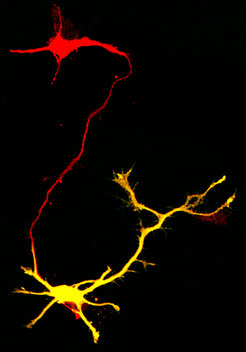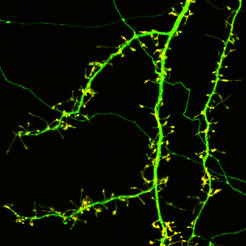Neddylation – hardly known, yet crucial
Protein modification allows nerve cells to form communication sites
Neddylation is a recently described modification of proteins in our cells. Neuroscientists of the Max Planck Institute of Psychiatry in Munich discovered that neddylation plays a very important role in the development and function of nerve cells in the brain, especially at their communication sites. Thus, neddylation might be an attractive candidate to be further explored in the context of neurodegenerative disorders, such as Alzheimer’s disease.

Genes on the DNA are transcribed into RNA. The RNA molecules in turn are translated into proteins which carry out specific tasks in the cells. Proteins can still be further modified. Recently, a new type of modification named neddylation has been discovered. Thereby, specialized enzymes conjugate the very small protein Nedd8 to target proteins. In some cases neddylation favors or inhibits degradation of the target proteins, in other cases neddylated proteins can perform new tasks.
Neuroscientists in the research group of Damian Refojo at the Max Planck Institute of Psychiatry in Munich discovered that protein neddylation plays a very important role in the development and function of nerve cells in the brain. Nerve cells, also known as neurons, are specialized cells transmitting information inside the brain and from the brain to other body parts. For example, they allow us to think, move or talk.
Neurons communicate with one another via synapses. “For the first time, we could demonstrate that neddylation is an active post-translational modification of proteins in these synapses,” states Annette Vogl, PhD student and first author of the current study published in the renowned scientific journal Nature Neuroscience.

To form synapses, one neuron contacts a second neuron at small protrusions, the so-called spines. Nerve cells can contain hundreds to thousands of spines and thus can communicate with many other neurons. “Taken together, we found that neddylation of proteins is a key factor for spine maturation during the development of neurons. Later on, also the maintenance of these spines requires neddylation,” explains Annette Vogl. “Adult mice in which neddylation was shut off in the forebrain showed spine shrinkage and elimination. These mice had severe learning and memory deficits.”
Neddylation was found to regulate proteins associated with disorders such as Parkinson’s and Alzheimer’s disease. Thus, neddylation might be an attractive candidate to be further explored in the context of neurodegenerative disorders.
AN

